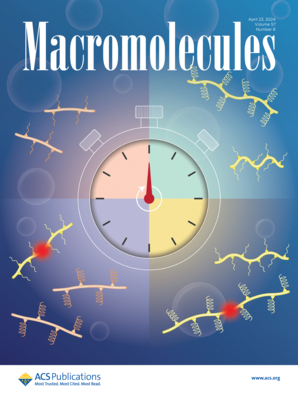Macroporous Polymers with Interconnectivity Gradients: Photopolymerization of Emulsion Templates Controlled by Height-Dependent Light Intensity
IF 5.1
1区 化学
Q1 POLYMER SCIENCE
引用次数: 0
Abstract
Gradient porous polymers are engineered to vary the pore size, porosity, and interconnectivity in a single direction, enabling controlled mass transport and mechanical properties. This unique design makes them ideal candidates for applications in tissue engineering scaffolds, advanced filtration systems, and absorbent materials for environmental remediation. While various methods have been developed to create porous polymers with gradients in pore size and porosity, techniques for generating openness gradients remain largely unexplored. In this study, we present a novel approach for producing porous materials with a gradient openness through the photopolymerization of emulsion templates. By modulating the light intensity across the height of the emulsion templates during the photopolymerization process, we induce a gradual change in openness within polymerized high internal phase emulsions (polyHIPEs). This effect arises from the interplay between interfacial and bulk polymerization, influenced by the partitioning behavior of photoinitiators in the continuous phase, light intensity, and distance from the light source. Stronger light sources enhance the openness and produce more pronounced openness gradients. The progressive attenuation of light within the emulsion templates is primarily governed by UV transparency, which is controlled by incorporating different radical monomers, such as acrylic acid and acrylamide. This single-step process allows for the fabrication of porous polymers with precisely tuned mass transfer properties through controlled interconnectivity gradients.

具有互联梯度的大孔聚合物:通过高度相关的光强度控制乳液模板的光聚合反应
梯度多孔聚合物可在单向改变孔径、孔隙率和互连性,从而实现可控的质量传输和机械性能。这种独特的设计使其成为应用于组织工程支架、先进过滤系统和环境修复吸收材料的理想候选材料。虽然已经开发出了各种方法来制造具有孔径和孔隙率梯度的多孔聚合物,但产生开放性梯度的技术在很大程度上仍未得到开发。在本研究中,我们提出了一种新方法,通过对乳液模板进行光聚合来制造具有梯度开放性的多孔材料。在光聚合过程中,我们通过调节乳液模板高度上的光强,诱导聚合高内相乳液(polyHIPEs)的开放性发生渐变。这种效应源于界面聚合和体质聚合之间的相互作用,并受到连续相中光引发剂的分配行为、光强度以及与光源的距离的影响。较强的光源会增强开放性,并产生更明显的开放性梯度。光在乳液模板中的逐渐衰减主要受紫外线透明度的影响,而紫外线透明度则可通过加入不同的自由基单体(如丙烯酸和丙烯酰胺)来控制。这种一步法工艺可以通过控制互连梯度,制造出具有精确调节传质特性的多孔聚合物。
本文章由计算机程序翻译,如有差异,请以英文原文为准。
求助全文
约1分钟内获得全文
求助全文
来源期刊

Macromolecules
工程技术-高分子科学
CiteScore
9.30
自引率
16.40%
发文量
942
审稿时长
2 months
期刊介绍:
Macromolecules publishes original, fundamental, and impactful research on all aspects of polymer science. Topics of interest include synthesis (e.g., controlled polymerizations, polymerization catalysis, post polymerization modification, new monomer structures and polymer architectures, and polymerization mechanisms/kinetics analysis); phase behavior, thermodynamics, dynamic, and ordering/disordering phenomena (e.g., self-assembly, gelation, crystallization, solution/melt/solid-state characteristics); structure and properties (e.g., mechanical and rheological properties, surface/interfacial characteristics, electronic and transport properties); new state of the art characterization (e.g., spectroscopy, scattering, microscopy, rheology), simulation (e.g., Monte Carlo, molecular dynamics, multi-scale/coarse-grained modeling), and theoretical methods. Renewable/sustainable polymers, polymer networks, responsive polymers, electro-, magneto- and opto-active macromolecules, inorganic polymers, charge-transporting polymers (ion-containing, semiconducting, and conducting), nanostructured polymers, and polymer composites are also of interest. Typical papers published in Macromolecules showcase important and innovative concepts, experimental methods/observations, and theoretical/computational approaches that demonstrate a fundamental advance in the understanding of polymers.
 求助内容:
求助内容: 应助结果提醒方式:
应助结果提醒方式:


